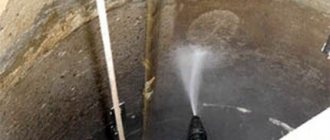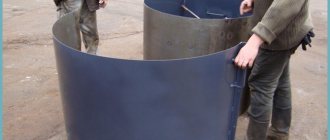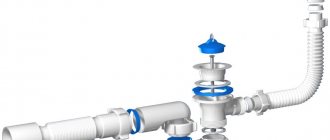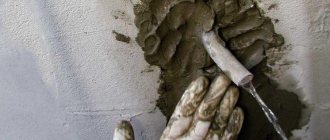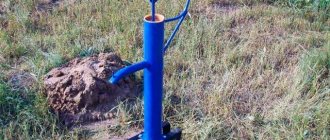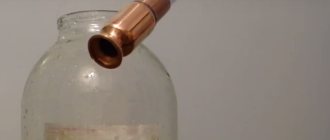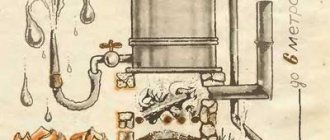Any tank in use needs to be cleaned. And a well filled with surface water is no exception. But, even knowing the need to regularly carry out this procedure, not all owners are ready to shell out large sums for the services of specialists.
Some people do the cleaning themselves - the work is quite labor-intensive and involves certain risks. However, by adhering to the methodology and observing safety precautions, it is quite possible to return the source of water intake to its former purity without the involvement of professionals.
We will tell you the reasons why the tank most often becomes clogged, we will describe how to carry out preventive and comprehensive cleaning of a well with your own hands, and we will also provide tips on maintaining the water intake point.
How do you know when it's time?
There are many factors that indicate that it is time to clean your well. In order to achieve the best results when performing this work, it is important to know the cause and root of the problem. There are several signs:
- unpleasant odor;
- color;
- the presence of impurities, etc.
The most common problems:
| Problem | Consequences and causes |
| Silting | As a result, the liquid becomes cloudy. Clay and sand deposits are observed at the bottom |
| Oil film | Sign of petroleum products. The reason may be depressurization of the mine |
| Rusty water | This is explained by the large amount of iron in the liquid. |
| Bacteria | When water from a source is rarely used, bacteria grow in it. The cause may be household waste that has fallen into the mine, such as animals/birds, etc. |
| Unpleasant smell | One of the reasons is sewage infiltration |
| Green water | The cause may come down to algae. Germinate when exposed to large amounts of sunlight |
| Muddy water | In most cases, the reason for this is a failed bottom filter. |
Cleaning is also required when you notice a decrease in the fluid level. In almost all cases, this work can be done independently, without the involvement of specialists.
When is it time to clean your well?
A properly made well can last for decades. But even a well-equipped building becomes dirty over time.
Falling leaves and dropped foreign objects cause biological processes. And metal impurities can even worsen its condition, making it potentially dangerous to human health.
A number of signs will indicate that a well at your dacha needs to be cleaned:
- The water acquired an unpleasant odor and a strange taste.
- Well water changed color and thread-like fibers began to appear in its composition.
- A clay deposit formed on the walls of the structure.
- The dynamic and static water level has dropped.
It is recommended to check the quality of drinking water annually. The procedure is best performed in the off-season. Testing and analysis of water from a well for the concentration of impurities and substances in it is ordered in specialized SES laboratories.
A yellow tint indicates a high concentration of iron, a green color indicates active growth of algae, and a brown-black color indicates the presence of decay products of organic matter.
How often will it be correct?
Ideally, once a year. The spring season is predominantly chosen.
Advice : even if you don’t experience any of the signs listed above, preventive cleaning will get rid of possible problems.
Regardless of whether you carry out preventive maintenance or routine cleaning of the source, it should be done on time, when the snow has completely melted. Otherwise, there is a risk that the drained liquid will return to the source through the high water.
Cleaning the well using the drainage method
To clean the mine, it is necessary to organize the use of drainage equipment and water circulation.
The pumping equipment should be installed at the bottom of the well on a stand 10–12 cm wide. If this is not done, the unit will be pulled into the silt. Near the shaft, you need to prepare a storage tank (an old bathtub or a 300-liter barrel will do), and lower the pump pressure hose to the bottom.
How to prepare an autonomous sewer system for winter
It is necessary to attach the injection unit to the top of the pump barrel, which will be needed to pump water back into the well. The unit must be equipped with a hydraulic nozzle, thanks to which a jet of the required density is formed, which acts as a scraper.
When flushing the well, both devices should be turned on in turn:
- drainage pump - for pumping dirty water from the bottom of the well;
- pressure pump - to generate a dense flow that will clean the walls and bottom of the well.
The hydraulic nozzle for removing deposits from the walls of the well can be controlled both from a ladder and from the ground.
During the procedure, the pump for cleaning the well from sand must sometimes be removed and its filter elements cleaned. This must be done until the filters stop collecting dirt, that is, the next time the pump is raised, they will be clean.
For major well cleaning, more powerful pumps are used, equipped with large filters, adapted to pass contaminated water with inclusions of silty fibers. The procedure consists of several stages, which are not so quick to complete - sometimes it may take a couple of days. The frequency of these activities depends on the nature of the soil.
After major cleaning, it is necessary to maintain cleanliness in the mine - carry out preventive maintenance with a drainage pump a couple of times a year.
Methods for cleaning a mine in a country house from silt and dirt
There are two main methods:
- To go down.
- Don't go down.
In the first case, serious precautions must be taken to complete the work. But you can achieve a better result, because you can really see what is happening at the bottom of the source.
The second method is a safe method. To solve the problem, special pumping and other equipment is used.
Carelessness can be fatal for a worker. There are a number of measures you should definitely take:
- You should not do the work yourself: at least three people.
- When descending into a mine, a safety rope attached to the belt must be used.
- Before starting, make sure there are no gases.
- If tools fall from above, the worker below must press as tightly as possible against the wall. Moreover, work should be carried out wearing a protective helmet.
- It is unacceptable to stand at the bottom of a well at one point for a long time.
- You should not cleanse those who have heart problems.
- The ladder used must have a platform at the bottom and be securely hooked to the top with a rope.
- Use reliable equipment, including a bucket, rope, etc.
Hardware installation errors
Vibrating pumps are very affordable and durable; they are often used in summer cottages, but they are not suitable for all wells. If there is quicksand at the bottom, the vibration activates it and muddy water appears, which takes a long time to settle.
You need to select equipment taking into account the parameters of the well: depth, column height, speed of level restoration after sampling. A high-quality pump hung incorrectly will stir up the water and draw in suspended silt. This leads to clogging of the water supply system and breakdown of the equipment itself.
Manual cleaning: what needs to be prepared?
Prepare the following tools, materials and clothing in advance:
- Safety rope.
- A long staircase. Instead, you can use a rope swing with a board tied at the bottom.
- Durable bucket.
- Metal brush.
- Cable for lifting a bucket.
- Cable for lifting and holding a ladder.
- Slings.
- Drum for raising water.
- Winch.
- Rubber boots.
- Helmet.
- Protective waterproof overalls.
A complete set of everything you need will allow you to carry out the work quickly and efficiently.
How to clean a well yourself
To understand how to clean a well yourself, you must first determine the nature of the contamination. Depending on the degree and cause of clogging of the water and mine walls, the appropriate method and tool are selected.
The standard procedure for major well cleaning is carried out in 5 stages:
- Stage 1 – preparation for the cleaning process;
- Stage 2 – pumping water from the well;
- Stage 3 – cleaning the shaft walls and working with cracks;
- Stage 4 – treatment of the well bottom;
- Stage 5 – water disinfection.
Attention! After the procedure has been completed, it is recommended to use preventive measures to help keep the well clean for a long time. How to prevent water contamination is described in the section below.
Stage 1 – preparation for work
The preparatory stage is considered basic - the quality of further work depends on it. First you need to collect the tools that will be needed in the process.
To clean the walls of the mine, it is better to have a hose with a constant flow of water Source skolodez.ru
To clean wells you will need the following equipment:
- safety rope to prevent falls from a height;
- protective helmet to prevent head injury;
- a long staircase to go down into the mine;
- gloves to protect the skin of the hands;
- a clamshell or bucket for cleaning the bottom;
- scraper or metal brush for cleaning walls;
- concrete solution that seals cracks;
- spatula for caulking seams.
It is important to know! Before cleaning the well, it is necessary to ensure free access to the shaft. To do this, it is advisable to dismantle the existing canopy and remove all unnecessary items.
Next, it is advisable to remove large debris from the surface of the water. This is done using a net or by hand, if possible.
Stage 2 - how to pump out water
After removing large debris, the water must be pumped out. This can be done in two ways - using buckets or a pump. The first method involves a long, complex procedure, so it is recommended to use the second.
Advice! When pumping water with a pump, you should remember the maximum level to which the device is allowed to be lowered. Violation of the indicators established by the manufacturer may lead to breakdown.
There is no need to pump out the water completely; there will still be some liquid left at the bottom of the shaft.
With a pump it is easier and faster to pump water out of a well Source hanover.com
The process of cleaning a mine made of concrete rings with your own hands
Let's take a closer look at how to do this correctly, without using a pump. All work consists of several successive stages, such as:
- Pumping out.
- Inspect and clean the bottom filter.
- Analysis and repair of joints between reinforced concrete rings.
- Mine cleaning.
The first step is to solve the pumping problem. The easiest way is to use a pump. If it is missing, then pumping is done with buckets. A very long and labor-intensive process. In the latter case, a winch and a drum are installed to lift the buckets.
Advice : this work should be done one at a time, because one person will be under a serious load. It is important to reach the conveyor so that the liquid is continuously pumped out.
You can pump out liquid with a pump within a couple of tens of minutes, but the same work using buckets will require several hours.
The next step is cleaning the walls of the shaft. Lower the ladder into it and secure it. You need to start working from top to bottom.
For cleaning, a metal brush or some kind of scraper is used; some use a hoe. Very convenient as they have a long handle.
Having cleaned the walls of the shaft, it is necessary to begin cleaning the bottom of the well. First, sand, silt, dirt, etc. are scooped out using buckets. Once you fill it, you give a signal to remove it. Gradually the bottom will be cleared of silt and other contaminants. The condition of the bottom filter must be checked. If necessary, it can be replaced or the existing one washed.
The condition of each seam between the reinforced concrete ring should be inspected. If there are cracks or the existing mortar is peeling off, then you should completely remove the old putty, prepare a new mortar and seal the joints with it. Also, everything is covered with a waterproofing material, which is allowed in direct contact with clean water.
At the end of the work, the entire mine is disinfected. You can use ten percent bleach and a bucket of water. Having mixed them, you simply coat the walls with this composition. In this way, disinfection occurs, and all existing microorganisms will simply die out.
Sand well pump
High-performance centrifugal pumps of the Grundfos type are not suitable for sand wells - a uniform, powerful flow of pumped water will not only quickly drain a low-yield well, but will also pull a large amount of sand to its water intake part, reducing the flow rate.
vibration pumps "Baby" type
The most suitable pump for a sand well is the much less efficient “Malysh” vibration pump. Such a pump, unlike the centrifugal Grundfos, is less sensitive to solid particles entering the mechanism. In addition, the constant vibration of the “Malysh” pump regularly shakes the mesh filter, knocking off stuck particles and clearing the way for water.
The internal diameter of the strainer must be no less than the internal diameter of the casing pipe. In this case, the pump can be lowered directly into the water intake area. As a result, the vibrations emanating from the mechanism will better clean the filter mesh.
How to clean clay without going down into it?
A special self-priming pump is used. Difficulties may arise when performing work, as layers of gravel, sand, and crushed stone form at the bottom. If the well is not cleaned in a timely manner, these layers will become compacted among themselves. A high-power pump is required that can quickly pump out liquid.
Important : if you use a weak pump, you can provoke even greater contamination of the well. Moreover, the device itself will simply burn out under heavy load.
The work begins with the following:
- Lower the pump to the bottom for cleaning.
- It dives to a distance from the bottom to one meter, maybe half a meter.
- Then the pump turns on and the dirt is pumped out.
- Afterwards, the liquid from the pump should be directed back into the shaft. The jet will break up all sediments at the bottom.
It is extremely important to lift the device to the surface from time to time in order to clean the filters. The process is repeated until clear liquid comes out or until no large inclusions remain.
Before disinfecting water in a well, you can take it to the laboratory for testing.
Tip : You can use a clamshell bucket to automate the process.
Features of using a grab bucket
A grab is a structure consisting of two buckets. In the center they are connected by oblong-shaped hinge levers. A chain or cable is attached to the edges of the buckets, which will pull to close the grab bucket. It will be good if it is light in weight.
Using a grab bucket completely eliminates the need to go down into the mine yourself. Its use will allow you to lift silt, sand and other dirt from the bottom of the source. The work can be done virtually alone, but it will be easier with assistants.
Before using it, the liquid must be completely pumped out. Then the work is carried out in the following sequence:
- The grab bucket is suspended by a cable.
- During descent, silt is captured (due to its falling under its own weight).
- Then pull the cable and the buckets will close. A locking ring is installed to prevent them from opening when lifted.
- Next, the grab is lifted by a cable to the surface.
- The buckets open. All trapped silt, sand and the like are removed from them.
This tool is considered optimal for cleaning the bottom of a well.
Rocking the well
The advice to pump a well, which gives water a little and slowly, is suitable for wells in dense clay. The water in it is washed for a long time, sometimes it takes several years for the well to work at full capacity.
Severe turbidity can result from uncontrolled pumping of water. This happens after a sharp increase in water consumption, for example, filling a swimming pool. Then in a good well, where the water was clean yesterday, turbidity appears, which cannot be settled by settling. To avoid an annoying situation, do not perceive the performance of a home well at an industrial level, so as not to regret it later.
Disinfection, cleaning products
There are several disinfection methods that can be used to disinfect water in a well.
White
The volume of whiteness should be calculated based on one can per ring. After treating all the walls of the shaft with this solution, you should leave it for a day. The head must be covered with plastic film.
Tip : When disinfecting a home well using bleach or chlorine, be sure to buy protective gloves and a respiratory respirator.
After a day, all accumulated liquid should be pumped out. If necessary, you can pump it out several times during the week.
Potassium permangantsovka
Simple potassium permanganate will allow for high-quality disinfection of country wells with drinking water. One tablespoon of potassium permanganate is needed per bucket. Dilute it by mixing thoroughly. Pour the entire product into a source to clean it of bacteria. Afterwards you need to wait about two hours, closing the head. After the time has passed, pump out the water. You can pour it into the garden; this composition will be beneficial for the soil.
Bleaching powder
If the liquid in the source has been contaminated with bacteria or contaminated with organic matter, then a bleach solution is used. One liter of water requires 20 milligrams of bleach.
Causes of pollution
There are many reasons why water in a well loses its original purity and freshness. Let's highlight those that owners encounter most often:
- Irregular use - stagnation and siltation of water can occur with infrequent use. Most often this happens when no one lives permanently at a country dacha and the hydraulic structure is used only from time to time.
- Lack of a cover - it is necessary to ensure that the well is tightly covered. It should only be opened at the time of use. Otherwise, dust, small debris, branches and leaves from trees will fall into the mine, significantly reducing the quality of the water. The presence of a lid will also protect from direct sunlight, which will significantly reduce the rate of growth and development of algae.
- Incorrect installation of the melt water shutter - the shutter is a permanent waterproof layer at least 50 cm thick covering the upper casing ring. If the technology was not followed during construction, perched water containing eroded pieces of soil and other debris will penetrate into the reservoir.
- Damage to seam joints - over time, cracks can form in the seams of concrete rings, through which groundwater enters the mine. The situation can be corrected by draining the tank and sealing the cracks with a mixture of mortar and liquid glass.
- Displacement of the rings most often occurs due to the impact of quicksand or soil freezing. In the first case, the lower part of the trunk moves, in the second, the upper rings are pushed out. To eliminate damage, the rupture sites are sealed with cement mortar or the displaced rings are tightened with pins with thick wire.
The tight lid reliably protects against external debris and sunlight from entering the tank.
Having found the reason why the well is dirty, you can determine the required amount of work and choose the most suitable cleaning method.
Preventative work
It is recommended to do this up to three times a year: in winter and at the end of summer, when the liquid level drops, but provided that the source is used intensively.
Potassium permanganate, iodine, or another drug described above can be used as prophylactic agents. Some tablets may also be used. But for this you need to read the instructions for their use.
Further actions
Now that the sludge has been pumped out, it all depends on how your pit is constructed. If it is sealed (the bottom is concrete, for example), then the work is over - you can continue to safely use the toilet.
If you left the bottom earthen or covered it with crushed stone, you need to make sure that in the near future the hole is not covered with clay again.
Filling the drainage hole with crushed stone
Sandy soils absorb moisture well. After cleaning, you can renew the gravel layer and use it. But to be honest, this is not a very good solution. The gravel will quickly become covered with silt again, and all procedures will have to be repeated .
Still, it would be better to spare no effort and money and pour a concrete foundation (this is especially true for cesspools in loamy soils). This will help significantly delay the time for your next serious drain cleaning!
Treatment facilities are simply necessary for waste disposal in a private home. Various types of waste disposal devices - polymer tank, septic tank, cesspool. System care. You might be interested in learning about ways to unclog clogs in your sink. Read here about how to clean pipes using a plunger, plumbing cable and chemicals.
What is the price?
If you are unable to cope with the task, you can contact specialized companies. Approximate prices in rubles:
- cleaning a mine up to five rings deep - about 5 thousand;
- repair and sealing of one seam - about 300;
- waterproofing one seam - about 300;
- source pumping – about 2.5 thousand;
- disinfection with manganese – about 3 thousand.
In any case, the cost will be determined individually, because each case is unique (region, distance from the city, etc.). You can focus on these prices before contacting specialists. As for the work guarantee, it is approximately one year. This is true if the source is not used so intensively. If it is the main source of water, you will have to clean it twice a year.
Digging a well in a new location
According to Lambov, water can also escape if the well was dug in the wrong place, and the aquifer on which he was working began to give up moisture to an additional source. In this case, you will need to dig either to the next aquifer, which is most often located at depths exceeding 5 meters, or to dig a well in a completely different place.
You can dig wells at any time, with the exception of spring floods. The most favorable time for constructing a well is August-September, since aquifers at this time have the lowest levels and there is the least risk of not digging it.

